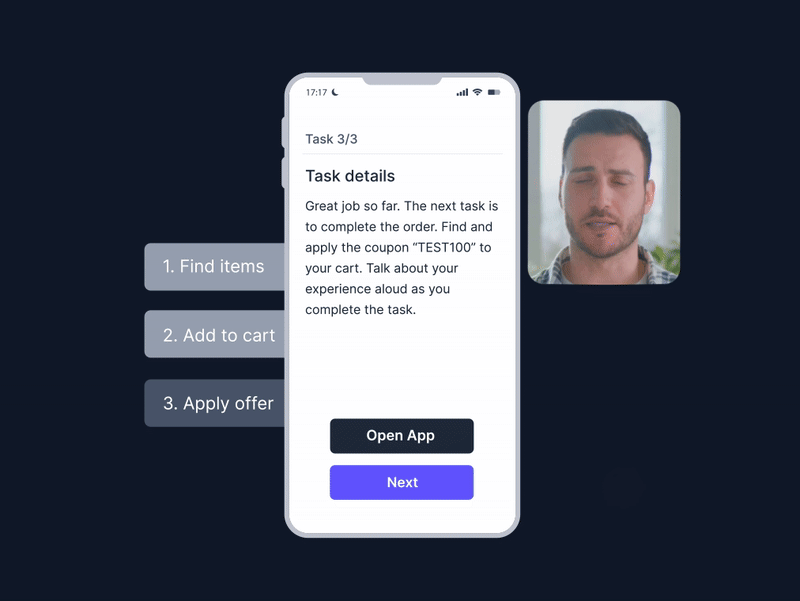Guidebook
The Modern Researcher’s Guide to UX Testing in 2025

Table of Contents
Introduction: The UX Reset
User expectations have never been higher—and patience never thinner.
In 2025, digital experience isn’t just part of your product. It is the product. Whether you’re refining a mortgage application flow, designing an e-commerce checkout, or launching an AI-driven chatbot, UX directly influences trust, conversion, and retention.
Yet, many teams still operate with legacy research workflows—centralized, manually moderated, and weeks behind sprint cycles. That era is over.
This guide is your playbook for a modern UX research reality: fast, intelligent, cross-functional, and truly scalable.
The State of UX Research Today
The landscape has changed. Teams no longer have time for fragmented tools and manual processes. Here’s what defines UX research in 2025:
- Speed over perfection: Agile teams demand insights in hours, not weeks.
- Research democratization: Product managers, designers, and marketers run tactical studies without waiting on centralized teams.
- Unmoderated is the norm: Asynchronous, screen-recorded tests are the default—not the backup.
- AI is a research multiplier: From summarizing sessions to extracting quotes, AI reduces the burden of manual synthesis.
- Context is king: Insight quality and relevance still depends on thoughtful study design, clear tasks, and relevant participants.
Why UX Testing Looks Different in 2025
It's Continuous
Research doesn't wait for a finished product. Teams test early concepts, MVPs, and live features in real-world contexts.
It's Cross Functional
Research is no longer siloed. Designers, PMs, and marketers can all launch studies - with built-in guardrails that maintain rigor.
It's AI Native
Ai handles the heavy lifting: Writing tasks, tagging clips summarizing themes, and Surfacing followup questions.
It's Omnichannel
With users on mobile, desktop, and hybrid journeys, testing must reflect real usage. Tools must capture multi-device behavior seamlessly.
78% of businesses using AI in UX report faster decision-making, accelerating design and development cycles without sacrificing insight quality.
What Great UX Testing Looks Like in 2025
Trait
What it means
Fast
From test setup to insight delivery in under 24 hours
Unmoderated
Sync and scalable. No calendars, no Zoom invites
AI-Enhanced
Highlights: auto-tagged, summaries: auto-generated, transcripts: auto-analyzed
Cross-functional
Designed for product, research, design and marketing teams alike.
Flexible
Support testing of prototypes, live features, messaging, and concepts
Human-centric
Captures real voices and behaviors. At scale, with nuance
Trait | What It Means |
Fast | From test setup to insight delivery in under 24 hours |
Unmoderated | Async and scalable—no calendars, no Zoom invites |
AI-Enhanced | Highlights auto-tagged, summaries auto-generated, transcripts auto-analyzed |
Cross-Functional | Designed for product, research, design, and marketing teams alike |
Flexible | Supports testing of prototypes, live features, messaging, and concepts |
Human-Centric | Captures real voices and behaviors—at scale, with nuance |
What You Can Test Today
- Confusion in loan application flows
- Usability of deposit interfaces
- User comprehension of disclosure clauses
- Ease of finding and applying promo codes
- Behavior when navigating product detail pages
- Effectiveness of in-store-to-app interactions
- Friction in appointment scheduling flows
Clarity of symptom checker tools
Behavior around mobile prescription refill tools
- Comprehension of quote comparison interfaces
Usability of claim submission journeys
Difficulty locating key information in policy documents
- Engagement with personalized homepage content
- Usability of playback features and controls
- Reactions to ad formats and interruptive experiences
- Validation of early-stage prototypes
- Clarity and resonance of messaging and content
- Experience consistency across mobile, desktop, and tablet
- Accessibility barriers and inclusive design feedback
How FC UX Enables Modern Testing
Fuel Cycle UX is built from the ground up to support modern, AI-native UX research. Key capabilities include:
AI Scenario Builer
Draft study tasks in Minutes
Flexible Participant Sourcing
Use FC's verified panels or your own audience
Instant AI Synthesis
Get clips, summaries and themes. Without hours of video review
No moderation required
Async workflow, ready for agile teams
Full Mobile & Desktop Capture
True Screen and audio recording on all devices
Integrated Quant & Qual
Combine behavior insights with structured survey date
"When product teams are under pressure to ship fast, research often gets left behind. FC UX ensures it never has to – bringing real user voices into every decision, instantly."
Anshul Divakar
Director, Product Management
Fuel Cycle
Best Practices for UX Testing in 2025
Start with Real Questions
Skip the academic framing. Focus on what you need to know to make a confident decision.
Use Templates, Not Blank Pages
FC UX includes tested templates for key flows. Sign-up, checkout, onboarding, etc.
Test in the Wild
Study behavior on actual devices in nature contexts. That's where friction lives.
Don't Wait for Perfect
Launch, lean, and iterate. Perfection is the enemy of insight velocity.
Broadcast your Insights
AI-Generated summaries, clips, and verbatim make it easy to share insights across teams, instantly.
The Future Belongs to Insight-Driven Teams
UX research is a driver of velocity, clarity, and user trust. With Fuel Cycle UX, teams can launch smarter products faster—without trading rigor for speed.
If your research still feels like a chore, it’s time for a reset. With FC UX, insight is just a few clicks away.